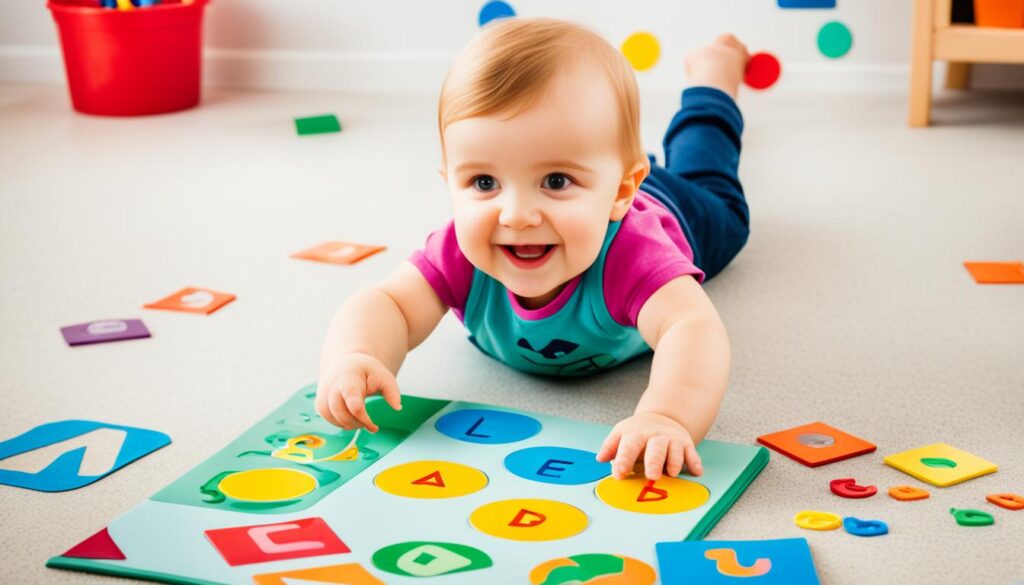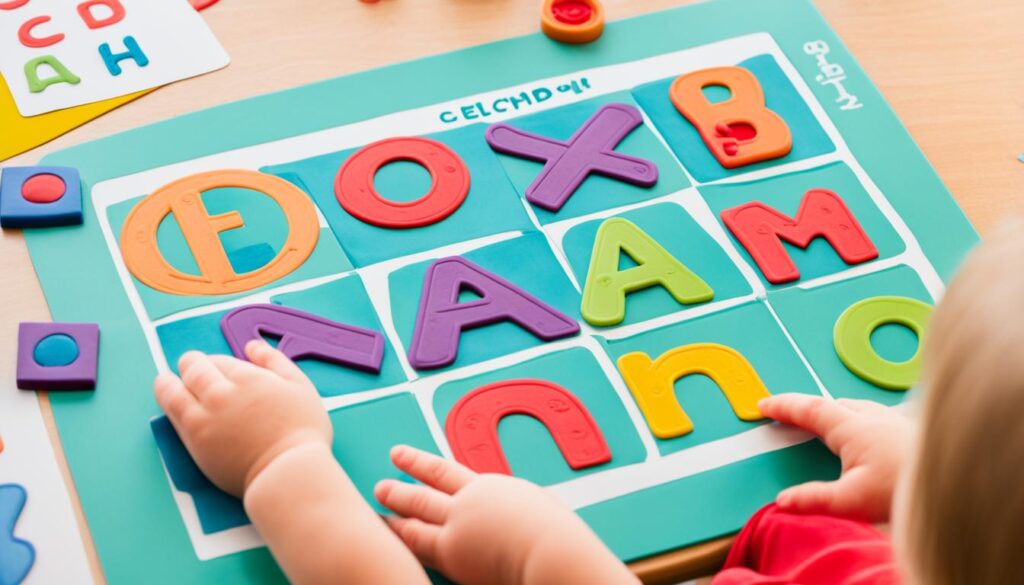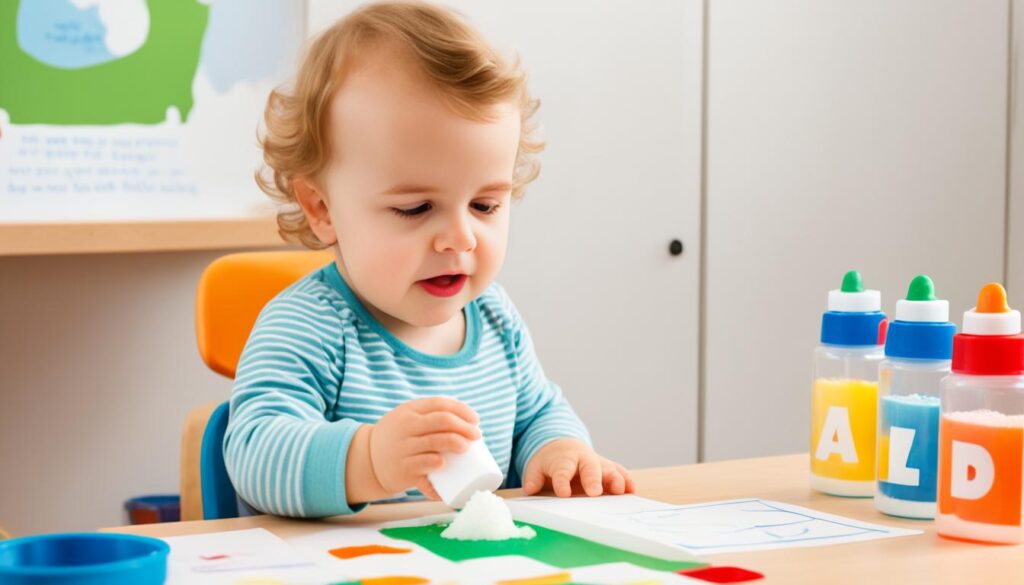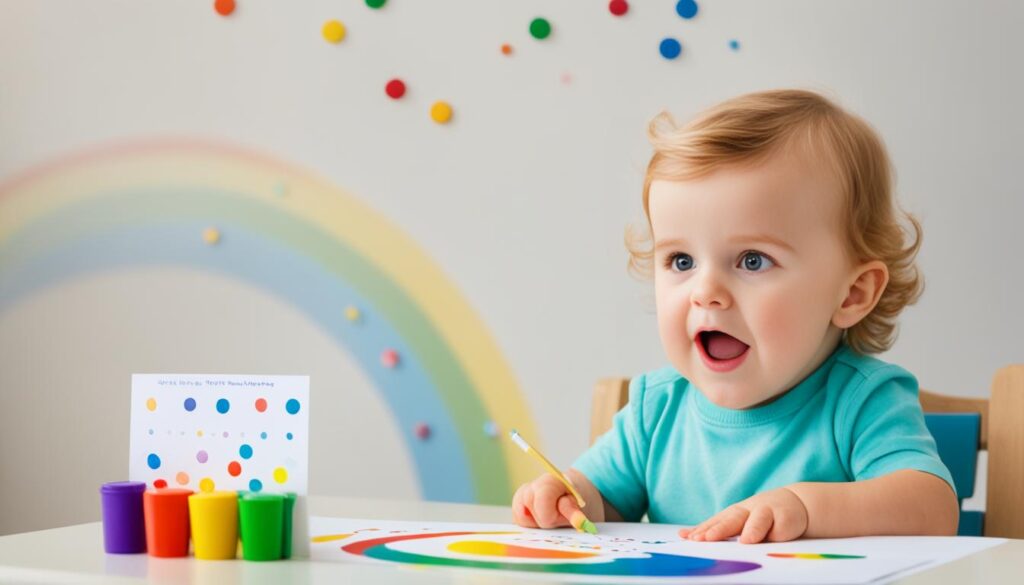Did you know that engaging young children in tracing activities can have a significant impact on their educational development? These fun and interactive tasks not only spark their curiosity, but also contribute to their overall growth.
Tracing activities offer a wide range of benefits for toddlers, helping them enhance their fine motor skills, hand-eye coordination, creativity, and problem-solving abilities. These activities provide a solid foundation for future writing tasks and foster a sense of accomplishment and satisfaction in toddlers. Plus, they offer a great opportunity for you to bond with your child while they explore and learn.
Key Takeaways:
- Toddler tracing activities promote fine motor skills and hand-eye coordination.
- These activities enhance creativity and problem-solving abilities.
- Tracing activities provide a sense of achievement and satisfaction for toddlers.
- They prepare toddlers for independent writing tasks in the future.
- Engaging in tracing activities strengthens the parent-child bond.
Benefits of Tracing Activities for Toddlers
Tracing activities offer numerous benefits for toddlers. Engaging in these activities helps to fine-tune their hand-eye coordination, which is essential for tasks like writing and drawing. Through tracing, toddlers develop their fine motor skills, enabling them to have better control over their fingers and hands. This improved coordination and control lay the foundation for future academic success. Tracing activities provide a perfect blend of fun and learning.
In addition to enhancing fine motor skills, tracing activities also foster creativity and problem-solving skills in toddlers. When given the freedom to trace and explore different shapes, patterns, and designs, toddlers are encouraged to think outside the box and use their imagination. Tracing becomes a canvas for their creativity.
Tracing activities also help toddlers develop the ability to follow steps and instructions. By following the lines and shapes when tracing, toddlers learn to focus and pay attention to details. This skill carries over to other areas of their lives, such as listening to directions and completing tasks.
Furthermore, tracing activities offer a sense of achievement and satisfaction for toddlers. When they complete a tracing activity, they feel proud of their accomplishment, boosting their self-esteem and confidence. This positive reinforcement motivates them to engage in more learning activities and further develop their skills.

Benefits of Tracing Activities for Toddlers:
- Enhances fine motor skills and hand-eye coordination
- Fosters creativity and problem-solving skills
- Develops the ability to follow steps and instructions
- Provides a sense of achievement and satisfaction
“Engaging in tracing activities helps toddlers develop their fine motor skills and hand-eye coordination, while also fostering creativity, problem-solving skills, and the ability to follow steps and instructions.”
Tracing activities serve as a stepping stone for toddlers to develop various important skills that will benefit them throughout their lives. From fine motor skills and creativity to problem-solving and following instructions, these activities offer a holistic approach to early childhood development.
| Benefits of Tracing Activities for Toddlers |
|---|
| Enhances fine motor skills and hand-eye coordination |
| Fosters creativity and problem-solving skills |
| Develops the ability to follow steps and instructions |
| Provides a sense of achievement and satisfaction |
Sensory Books and Toys for Tracing Activities
Sensory books and toys are valuable tools that can enhance the engagement and learning experience of tracing activities for toddlers. These interactive materials provide a multi-sensory approach, igniting curiosity, sparking imagination, and promoting active participation.
Spark Curiosity with Sensory Books
When it comes to tracing activities, sensory books specifically designed for toddlers can capture their attention and encourage exploration. These books engage multiple senses through touch and feel, captivating young minds and fostering a love for learning.
“Sensory books have been a game-changer for my toddler’s tracing journey. The textures and interactive elements make the activities more exciting and keep him engaged for longer periods of time!” – Parent Testimonial
Through sensory books, toddlers can embark on tactile adventures, feeling different textures, and discovering hidden surprises. By tracing the raised patterns or following grooved paths, toddlers develop their fine motor skills while immersing themselves in an interactive storytelling experience.

Encourage Creativity with Sensory Toys
Sensory toys complement tracing activities by providing avenues for imaginative play and creativity. These toys engage multiple senses, allowing toddlers to explore, manipulate, and create, expanding their cognitive and motor skills.
Open-ended sensory toys, such as playdough or building blocks, provide endless opportunities for toddlers to shape and mold their own narratives. By combining tracing activities with sensory toys, toddlers can enhance their fine motor skills while developing their ability to think critically and problem-solve.
“Sensory toys have transformed tracing activities into immersive playtime sessions for my toddler. It’s amazing to witness his creativity blossom as he incorporates different textures and materials into his tracing projects!” – Parent Testimonial
The combination of sensory toys and tracing activities creates a dynamic and engaging learning environment, allowing toddlers to unleash their imagination and express themselves freely.
Magnetic Prewriting Activity
Looking for a mess-free way to engage your toddler in tracing activities? Magnetic prewriting is the answer! With magnetic tools and surfaces, your little one can create letters, shapes, and words without the worry of crayons or markers making a mess. Not only does this activity keep your child entertained, but it also enhances their fine motor skills and hand-eye coordination.
Magnetic prewriting allows toddlers to practice tracing in a fun and interactive way. The magnetic tools provide a tactile experience, stimulating their sense of touch while they explore different shapes and letters. This hands-on activity promotes the development of fine motor skills as they manipulate the magnetic pieces with their fingers.
Repetition is key when it comes to learning, and magnetic prewriting allows for repeated practice. Toddlers can easily erase their creations and start over again, reinforcing their tracing skills and improving their hand-eye coordination. The magnetic surfaces provide a smooth and easy-to-clean canvas, making it a convenient activity for both children and parents.
Engage your toddler with magnetic prewriting activities that foster creativity, problem-solving skills, and a sense of achievement. Watch as they take pride in creating their own magnetic masterpieces and gain confidence in their tracing abilities.

| Benefits of Magnetic Prewriting Activity |
|---|
| Enhances fine motor skills |
| Improves hand-eye coordination |
| Promotes repeated practice and reinforcement |
| Fosters creativity and problem-solving skills |
| Provides a mess-free tracing experience |
Alphabet Tracing Playdough Mats
Looking for a fun and interactive way to help your toddler learn and practice their ABCs? Look no further than alphabet tracing playdough mats! These mats not only make learning the alphabet enjoyable but also provide a hands-on experience that engages your child’s senses.
With alphabet tracing playdough mats, your child can roll playdough into the shape of each letter and trace the dotted lines. This activity not only helps them develop their fine motor skills and muscle control but also reinforces letter recognition and sequencing.
Imagine the joy your toddler will feel as they mold the playdough into the shape of letter A, B, C and then trace each letter with their fingers. This interactive experience transforms ABC practice into a creative and enjoyable activity.
Playdough mats are versatile and adaptable, allowing you to customize the activity as your child progresses. Start with uppercase letters and then move on to lowercase letters. You can even introduce sight words or simple words for your child to trace.
Want to make it even more exciting? Incorporate different colors of playdough to make a rainbow effect. Let your child’s imagination run wild as they explore the world of letters and colors.
“Alphabet tracing playdough mats provide an engaging way for toddlers to practice their ABCs while developing fine motor skills and reinforcing letter recognition.”
This hands-on approach to learning is not only effective but also encourages creativity and imagination. Your child will enjoy the tactile experience of manipulating playdough while learning important skills.
So why wait? Start incorporating alphabet tracing playdough mats into your child’s learning routine and watch as they grow their fine motor skills, enhance letter recognition, and have a blast in the process.

| Benefits of Alphabet Tracing Playdough Mats: |
|---|
| Develops fine motor skills |
| Enhances letter recognition |
| Improves muscle control |
| Encourages creativity and imagination |
| Provides a hands-on learning experience |
Squeeze Bottle Salt Writing
If you’re looking for a fun and engaging sensory activity for your toddler that also promotes fine motor skills and letter and shape tracing, look no further than squeeze bottle salt writing. This simple activity allows toddlers to create lines, patterns, and even words using just a bottle filled with salt.
Here’s how you can set up this exciting sensory experience:
- Select a tray or a sensory bin to contain the salt. Make sure it’s a smooth surface to facilitate easy tracing.
- Fill a squeeze bottle with salt. You can find squeeze bottles in craft stores or repurpose a clean condiment bottle.
- Encourage your toddler to hold the squeeze bottle and squeeze it gently to create lines or shapes on the tray or sensory bin filled with salt. They can focus on tracing letters, numbers, or even their favorite shapes.
- As your toddler traces with the salt, they’ll practice their fine motor skills, hand-eye coordination, and concentration.
This activity provides a tactile and sensory experience for your toddler, stimulating their senses as they explore the texture of the salt and make unique creations. It’s a great way to introduce them to letter and shape recognition while also nurturing their creativity.
Here’s an example of what squeeze bottle salt writing can look like:

Give your little one the opportunity to develop their fine motor skills, concentration, and creativity through squeeze bottle salt writing. You’ll be amazed at what they can create!
Water Tracing on Chalkboard
Tracing and writing practice with water on a chalkboard is a simple yet effective activity for toddlers. By using a paintbrush dipped in water, toddlers can follow patterns, words, or numbers written on the chalkboard. This activity promotes fine motor skills, hand-eye coordination, and letter/number recognition. It also allows for easy cleanup and can be repeated multiple times.
This engaging chalkboard activity combines the sensory experience of water with the interactive nature of tracing, making it an ideal learning exercise for toddlers. The gentle strokes of the paintbrush on the chalkboard create captivating patterns as the water evaporates, providing a visual and tactile stimulation for young learners.
Harnessing the power of kinesthetic learning, water tracing on a chalkboard offers a hands-on approach to practicing letter formation, word recognition, and number sequencing. Toddlers can trace over pre-drawn patterns to develop their fine motor skills or follow along as you write new words and numbers on the chalkboard.
The versatility of this activity allows for customization according to your child’s developmental needs. Whether you focus on alphabet letters, sight words, or basic math concepts, water tracing on a chalkboard provides an interactive and dynamic learning experience.
Combine water tracing on a chalkboard with other activities, such as sensory books or playdough mats, to create a comprehensive educational session for your toddler. This multi-sensory approach enhances their engagement and helps reinforce their learning in a fun and interactive way.
Benefits of Water Tracing on Chalkboard:
- Promotes fine motor skills and hand-eye coordination
- Develops letter and number recognition
- Facilitates pattern and shape practice
- Encourages creativity and imagination
- Allows for easy cleanup and repetition
Water tracing on a chalkboard is a versatile activity that combines learning, creativity, and sensory engagement. With just a paintbrush and a chalkboard, you can create an interactive space where your toddler can practice tracing, discover new patterns, and enhance their cognitive development.

Captivating and educational, water tracing on a chalkboard is a delightful addition to your toddler’s learning journey. Watch as they trace, discover, and grow in their abilities to form letters, understand patterns, and express their creativity through this engaging activity.
Dot Marker Rainbow Name Tracing
Dot marker rainbow name tracing is a colorful and engaging activity for toddlers. By using dot markers, toddlers can create a vibrant rainbow of their own name. This activity not only helps develop fine motor skills but also reinforces letter recognition and the concept of name identification. Toddlers will enjoy the process of creating their personalized rainbow while developing their motor skills.
Using dot markers, toddlers can trace each letter of their name using different colors, creating a rainbow effect. This activity allows toddlers to practice their letter formation and strengthen their fine motor skills as they control the markers.
The rainbow aspect of the activity adds an element of fun and creativity, making it more visually appealing for toddlers. Seeing their name come to life in a vibrant rainbow brings a sense of accomplishment and pride for their efforts. It’s an engaging way to introduce them to the concept of colors and encourage their artistic expression.
By practicing name tracing with dot markers, toddlers also develop letter recognition skills. As they trace each letter and see it form their name, they begin to associate the written symbol with the corresponding sound. This lays the foundation for future reading and writing skills.

Tracing their name with dot markers is not only a fun activity, but it also promotes fine motor skills and reinforces letter recognition. The rainbow aspect of the activity adds an extra layer of excitement and creativity. This multi-sensory experience helps toddlers engage with their learning in a hands-on way.
Tips for Successful Dot Marker Rainbow Name Tracing:
- Make sure to use dot markers that are easy to grip for toddlers.
- Provide a template of their name with dotted letters as a guide.
- Encourage them to say each letter aloud as they trace it with the dot markers.
- Offer a variety of colors to create a vibrant rainbow effect.
- Celebrate their finished rainbow name with praise and displays of their artwork.
Dot marker rainbow name tracing is a fun and effective way to help toddlers develop their fine motor skills, reinforce letter recognition, and spark their creativity. Incorporate this activity into their playtime and watch as they enjoy the process of creating their own colorful masterpiece.
Conclusion
Engaging toddlers in tracing activities is a delightful way to promote their overall development and foster a love for learning. These activities provide a multitude of benefits, including the enhancement of fine motor skills, hand-eye coordination, creativity, and problem-solving abilities.
When toddlers engage in tracing activities, they experience a sense of accomplishment and satisfaction as they complete each task. These activities not only offer educational growth but also lay the foundation for future independent writing skills.
Moreover, tracing activities create engaging and enjoyable learning experiences for toddlers, helping them to build confidence, develop cognitive skills, and make meaningful connections between shapes, letters, and numbers. Furthermore, they strengthen the bond between parents and children, as they provide opportunities for playful interaction and shared experiences.
Can Mazes be Included in Toddler Tracing Activities for Learning?
Introducing fun toddler mazes for playtime can be a great way to incorporate problem-solving and fine motor skills into a toddler’s tracing activities. Mazes can provide an enjoyable and interactive way for young children to learn about shapes, patterns, and concentration while having fun.
FAQ
Can tracing activities help with the development of fine motor skills?
Yes, tracing activities are excellent for developing fine motor skills in toddlers. These activities require precise control of hand movements, which strengthens the muscles in their fingers and hands.
How do tracing activities enhance hand-eye coordination?
Tracing activities require toddlers to coordinate their hand movements with their visual focus. By following the lines and shapes they are tracing, toddlers improve their hand-eye coordination skills.
Do tracing activities foster creativity and problem-solving skills?
Yes, tracing activities encourage toddlers to think creatively and solve problems. They can experiment with different colors, shapes, and patterns while tracing, which helps stimulate their imagination and problem-solving abilities.
Can tracing activities help toddlers follow steps and instructions?
Absolutely. Tracing activities provide toddlers with a structured task that requires them to follow specific lines and shapes. This helps develop their ability to understand and follow steps and instructions.
Do tracing activities provide a sense of achievement for toddlers?
Yes, completing a tracing activity gives toddlers a sense of accomplishment and satisfaction. They can see their progress as they successfully trace lines, shapes, and letters, which boosts their self-confidence.
Will tracing activities prepare toddlers for independent writing in the future?
Yes, tracing activities serve as a foundation for independent writing. They help toddlers become familiar with the shapes and patterns of letters and build the motor skills needed for writing.
How can sensory books and toys enhance tracing activities?
Sensory books and toys can make tracing activities more engaging for toddlers. Books with touch and feel elements create a multi-sensory experience that sparks curiosity and imagination. Similarly, sensory toys encourage open-ended play and creativity.
Are magnetic prewriting activities mess-free?
Yes, magnetic prewriting activities are mess-free since they use magnetic tools and surfaces. Toddlers can create letters, shapes, and words without the need for crayons or markers, making cleanup easier for parents.
How do alphabet tracing playdough mats benefit toddlers?
Alphabet tracing playdough mats provide a tactile experience for toddlers. They can roll playdough into the shape of each letter and trace the dotted lines, which helps develop their fine motor skills and reinforces letter recognition.
What is squeeze bottle salt writing and what are its benefits?
Squeeze bottle salt writing is a sensory activity where toddlers create lines and patterns on a tray or sensory bin by squeezing a bottle filled with salt. It enhances fine motor skills, hand-eye coordination, and concentration, while also providing a tactile and sensory experience.
How can water tracing on a chalkboard benefit toddlers?
Water tracing on a chalkboard is a simple yet effective activity that promotes fine motor skills, hand-eye coordination, and letter/number recognition. Toddlers can use a paintbrush dipped in water to follow patterns, words, or numbers written on the chalkboard.
What is dot marker rainbow name tracing?
Dot marker rainbow name tracing is a colorful and engaging activity where toddlers use dot markers to create a vibrant rainbow of their own name. This activity helps develop fine motor skills, reinforces letter recognition, and encourages creativity.










